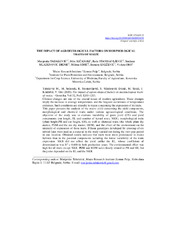Приказ основних података о документу
The impact of agroecological factors on morphological traits of maize
Uticaj agroekoloških faktora na morfološke osobine kukuruza
| dc.creator | Tabaković, Marijenka | |
| dc.creator | Sečanski, Mile | |
| dc.creator | Stanisavljević, Rade | |
| dc.creator | Mladenović Drinić, Snežana | |
| dc.creator | Simić, Milena | |
| dc.creator | Knežević, Jasmina | |
| dc.creator | Oro, Violeta | |
| dc.date.accessioned | 2022-04-21T11:04:30Z | |
| dc.date.available | 2022-04-21T11:04:30Z | |
| dc.date.issued | 2020 | |
| dc.identifier.issn | 0534-0012 | |
| dc.identifier.uri | http://rik.mrizp.rs/handle/123456789/857 | |
| dc.description.abstract | Climate changes are one of the crucial issues of modern agriculture. These changes imply the increase in average temperatures and the frequent occurrence of temperature extremes. Such conditions are stressful to maize concerning the expression of its traits. This paper presents the analysis of the maize yield concerning the yield components, morphological and chemical traits under various agroecological conditions. The objective of the study was to evaluate variability of grain yield (GY) and yield components (ear length, EL and number of kernel rows, NKR), morphological traits (plant height,PH and ear height, EH), as well as chemical traits (the whole plant dry matter, PDM and the ear dry matter, EDM), and the effect of the environment on the intensity of expression of these traits. Fifteen genotypes developed by crossing of six inbred lines were used as a material in the study carried out during the two-year period in one location. Obtained results indicate that traits were more pronounced in maize hybrids than in the parental components including the lower variability of the traits expression. NKR did not affect the yield unlike the EL, whose coefficient of determination was R2 = 0.600 in both production years. The environmental effect was high for all traits except NKR. PDM and EDM were closely related to PH and EH, but they also depended on the EL and the NKR.Variations in meteorological conditions have a significant impact on the final goal of the production, the yield. Prevailing agro-ecological conditions should be a major guideline in planning the crop production and selecting the genetic material. | sr |
| dc.language.iso | sr | sr |
| dc.language.iso | en | sr |
| dc.publisher | Belgrade : Serbian Genetics Society | sr |
| dc.publisher | Beograd : Društvo genetičara Srbija | sr |
| dc.rights | openAccess | sr |
| dc.rights.uri | https://creativecommons.org/licenses/by-sa/4.0/ | |
| dc.source | Genetika | sr |
| dc.subject | yield, yield components, variability, environment | sr |
| dc.title | The impact of agroecological factors on morphological traits of maize | sr |
| dc.title | Uticaj agroekoloških faktora na morfološke osobine kukuruza | sr |
| dc.type | article | sr |
| dc.rights.license | BY-SA | sr |
| dc.citation.volume | 52 | |
| dc.citation.issue | 3 | |
| dc.citation.spage | 1203 | |
| dc.citation.epage | 1213 | |
| dc.identifier.doi | 10.2298/GENSR2003203T | |
| dc.identifier.fulltext | http://rik.mrizp.rs/bitstream/id/4365/gen_2020-52_3.pdf | |
| dc.type.version | publishedVersion | sr |


